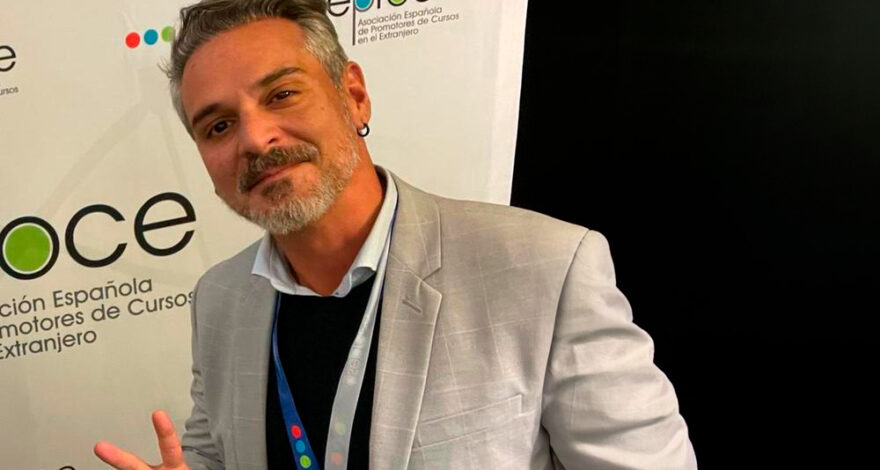Gabriel Barros, Associate Director at Berlin School of Business, Shares His Insights on Higher Education in Germany and Its Impact on the Spanish Market.
In recent years, the Spanish market has focused more on academic year programs, summer courses, and language courses. However, there seems to be a shift towards Higher Education. What is driving this change?
This shift stems from the realization that, during the pandemic, Higher Education not only remained stable but grew significantly. More mature students are constantly looking to update their skills to stay competitive in the job market.
Additionally, the time required to manage a Higher Education student is much less when compared to other programs, allowing agencies to serve more clients and increase their performance by as much as threefold.
The average age at your school is 28 for master’s students and 24 for undergraduate students. Does this suggest that their previous studies did not equip them with the necessary tools to be competitive?
On average, students entering master’s programs are around 28 years old, while undergraduate students range between 22-24 years old. This is because the professional environment is constantly evolving, requiring new skills and updated knowledge. To remain relevant and improve their opportunities, these students seek to complement their education with a master’s degree or a new undergraduate program. This scenario reinforces the importance of lifelong learning as a key factor for professional success.
Political events and insecurity in many countries are driving students to continental Europe, whereas they previously considered other destinations.
In recent years, political and economic instability, as well as migration restrictions, have made traditional destinations such as the U.S., the U.K., and Canada less attractive. In contrast, continental Europe has emerged as a more stable and accessible option, offering high-quality universities, English-taught programs, more competitive costs, and better residence and employment opportunities. Additionally, free movement within the Schengen area makes studying in Europe even more appealing to international students.
European countries offer almost free education as a major advantage, which has limited outward mobility beyond the Erasmus program.
Demand continues to grow, especially in European countries with weaker economies. Students seek education abroad for two key reasons: access to specialized programs unavailable in their home country and better job opportunities.
In Southern Europe—Spain, Portugal, Greece, and Italy—the cost of living is rising while salaries remain stagnant. In contrast, Germany, particularly Berlin, offers higher salaries, a lower cost of living, and public benefits, making it an attractive study destination.
On the other hand, Nordic countries present a completely different economic landscape. There, strong government incentives with dedicated budgets fund studies abroad. These investments aim to provide their citizens with international academic and linguistic experiences while allowing them to specialize in fields that are not as developed in their home countries.
Housing and accommodation are becoming major challenges in Western countries. How are you addressing this issue?
Yes, that is true. Interest in studying in the Netherlands has declined due to the high cost of living and lack of accommodation, despite low tuition fees.
For now, in our locations (Hamburg, Berlin, Barcelona, and Paris), this issue is not as severe due to a greater supply and still-accessible prices. Nevertheless, we proactively support our students by providing an accommodation guide and partnerships with housing providers that offer special discounts.
Our agencies have a vast database of short-term stay and academic year students. What should we do to take our students further?
You already have all the necessary resources; now, it’s just about using them strategically. You already have a large number of clients. They only require minimal training, as experience is refined with practice. The most important thing is to promote your services and ensure that your audience knows that you now offer Higher Education programs as well, preventing them from seeking guidance elsewhere or navigating the process alone.
There is a belief that students will figure things out on their own and won’t use agencies. How do you think agencies can be motivated and trained to promote Higher Education programs?
Many people will continue to seek agencies due to the convenience and time savings they provide. With their expertise and connections, agencies streamline the process, reduce bureaucratic stress, and help students make better cost-benefit decisions. Beyond promoting programs, highlighting these advantages is key to attracting new leads.
You are a Brazilian who has lived in Brazil, Spain, Australia, the U.S., Ireland, and Italy. How has your personal experience helped you in your current role?
It’s a very simple answer: there’s no better learning experience than that of being a client of this very industry. I have participated in programs such as High School Public USA J1, Work & Travel, Volunteering, and I also completed my Higher Education abroad. Additionally, I worked for years in an agency, which gives me a comprehensive perspective and experience in the three key pillars of the sector: student, agent, and provider.
Berlin is one of Europe’s most exciting cities, having undergone a physical and social transformation that even the most optimistic could not have imagined when they woke up on November 9, 1989. Do you think students are still aware of this, or does it feel like ancient history to them?
Absolutely, the city remains a living reflection of its past, with remnants of the Berlin Wall and its history shaping its cultural and academic environment. Although students did not experience this transformation firsthand, Berlin’s essence as a symbol of resilience and progress remains highly relevant, especially in an academic setting that fosters innovation and diversity.



